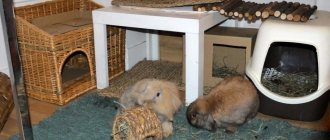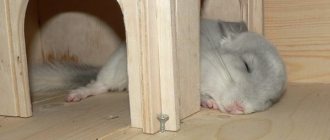- Other pets (cats, dogs) can harm decorative rabbits, so they should not be kept in the same room. In addition, it is not recommended to allow small children near small rodents.
- Rabbits can easily tolerate low temperatures, but suffer during the heat. In addition, they can get sick from excessive humidity, temperature changes and drafts.
- The cage with pets should not be placed near a heater, and direct rays of the sun should not enter the pet’s home.
It is better to allocate a separate room for rabbits - It is necessary to monitor hygiene in your pets’ home and clean their litter box in a timely manner, because due to the accumulation of a large amount of feces in the air, toxic ammonia vapors are formed, which negatively affect the well-being of rodents.
- The optimal temperature for keeping rabbits is 19-20 degrees. When this indicator increases, pets become lethargic and refuse to eat. To ease your rabbit's condition, it is recommended to wipe his ears with cool water or place a cup of ice near the cage.
In extreme heat, it is recommended to bathe the rabbit
- Rodents lead an active life in the evening and at night, so they should not be disturbed during the day.
- Hair care will vary depending on its length. Thus, long-haired pets should be regularly bathed and combed with a special comb, otherwise their fur will become tangled. While short-haired animals take care of it on their own.
Pets with long hair require careful grooming
- It is necessary to take a responsible approach to the choice of feed mixtures for these animals, because they are picky in this matter. Spoiled food or leftovers from the master's table are not suitable for pets. Without a balanced diet, they begin to eat their own feces, so fresh fruits or vegetables should always be present in the feeder.
Rules for feeding decorative rabbits
- If the pet comes into contact with other animals, then it is necessary to take care of annual vaccination, because almost all viral and infectious diseases lead to the death of rabbits.
Decorative rabbits are recommended to be vaccinated, like other domestic animals.
Housing requirements for domestic rabbits
Every owner wants to provide their pet with the most comfortable home possible, so before starting work on making a rabbit house, you need to familiarize yourself with the following rules.
So, even a pet of a dwarf breed requires a lot of space (at least four times more than the rabbit itself). The minimum length of the cage is 1 meter and the width is 60 centimeters. It should be taken into account that all equipment (feeders, drinking bowls, tray, toys) should be placed there.
It is better to choose natural materials for making a home, because rabbits react negatively to any toxic substances.
Wood is a durable, environmentally friendly material
A mesh floor is considered the most hygienic, but it is not suitable for pets of all breeds - this may cause damage to the paws of some dwarf rodents. Therefore, the floor in a cage or house is covered with a natural covering with a rigid structure (it must be resistant to moisture). You will also need to bend any sharp metal corners and ends away from the wire.
Alternative house options
Designing such small structures allows you to use your imagination and create a variety of buildings. Cell sizes are relative values and vary. If there are more individuals, then the house should be larger.
A wooden base is the most environmentally friendly choice. Possible options include lining and eco-glass.
The construction also depends on for whom the house has to be built: a rabbit, young animals or adults. If there is a female rabbit, then the house needs to be insulated, the young animals will need more freedom, so the size of the house is increased.
For the winter period, take ordinary cages and insulate them yourself using any means. The cracks are closed, part of the lattice is provided with organic insulation, and the cage is covered with something warm.
Making a house for a rabbit with your own hands
We will consider options for creating a comfortable home for rodents from different materials - this will significantly save your budget.
Project
The first step is to draw up a drawing indicating the size of the structure, the location of the door, and other elements. If you wish, you can develop your own scheme or take a ready-made version as a basis.
Approximate drawing of a cage for a decorative rabbit
Durable two-tier cage: step-by-step instructions
A two-tier dwelling is the best option for a rabbit, where it will have enough free space to move. The size of the structure from the inside will be 60x70 centimeters, taking into account that, according to the recommendations of experts, less than one square meter of space is required for each decorative rabbit.
The main advantage of the cage is that it is easy to move to any convenient place. You can even transport your pet in it.
A dwarf pet will feel good in a two-tier cage
Materials and tools
To build the cage we will need the following materials:
- plywood sheets (thick) - 3 pieces;
- plywood sheets (thin) - 2 pieces;
- boards (for supports, threshold, frame, ramp);
- net;
- legs (can be purchased at a furniture store);
- glue;
- fastenings
It is not necessary to purchase new materials for such purposes, because you can use parts from old furniture. In addition, you will need to prepare some equipment:
Let's start assembling
Step 1: First you need to make the base of the cage. In this case, we need to prepare bars 45 centimeters long, which will serve as supports. In addition, you will need to cut a rectangle measuring 60x70 centimeters from a plywood sheet.
Now you should make holes in the bars and then fasten them to the plywood using self-tapping screws
Step 2: now you need to make a partition wall, which will serve as the base of the upper tier. To do this, you need to cut the same rectangle from a plywood sheet as in the previous case. Only now an additional opening should be made on the lower left side through which the pet can get to the upper floor.
The size of the hatch should correspond to the dimensions of the grown rabbit
Step 3: Now you need to attach the plywood sheet (where there is an opening) to the posts.
Self-tapping screws are also used as fastenings
Step 4: now on thick sheets of plywood you need to mark the other two side walls (60x92 centimeters). Next, you will need to cut them out using a saw.
It is necessary to secure the walls to the frame so that the structure is level
Step 5: now you need to make blanks for the racks for the second tier, and the same plywood sides. It is necessary to attach all the walls and ceiling of the future home to the racks. The result should be a design like the one shown in the photo below.
Blank for the cage
Step 6: Now you need to make the threshold. It is necessary to prevent food and bedding from spilling out of the cage. It is better to make it from planks measuring 1.2×6 centimeters.
It should be screwed to the vertical supports using self-tapping screws
Step 7: Now you need to start making the door. It is recommended to make it from boards, and then connect them with staples and a furniture stapler.
If the structure is too fragile, you can strengthen the frame with metal corners
Step 8: for greater structural rigidity, attach a metal mesh to the frame using the same stapler.
Next, all that remains is to secure the door on the hinges and install the locking mechanism
Step 9: Now you should make a kind of staircase for the rabbit to the top floor, which in this case is a ramp. To do this, you need to cut out an oblong piece from plywood to fit the height of the cage. Since the ramp will be at an angle, the rabbit can easily slide off it. To prevent such consequences, it is necessary to sheathe it with soft material.
You can glue a piece of rubber mat or ice cream stick to the ramp
Step 10: Finally, secure the stable legs to the bottom of the cage.
You can glue a piece of rubber mat or ice cream stick to the ramp
Video - Making a cage for a rabbit on 2 floors
Features of wood processing
Since wood is a natural material, it can rot due to constant dampness (a rabbit can spill water, and the animal can go to the toilet directly on the floor of the cage or house). Therefore, upon completion of manufacturing, the structure should be treated with a special disinfectant solution - drying oil, as well as chlorine solution or iodine, are perfect for such purposes.
This composition must be applied to the walls of the structure from the outside and inside, after which it should be placed in the sun until completely dry.
Products made from natural wood must be treated with an antiseptic
In winter, after treatment, the cage can be placed next to a heater. You just have to periodically turn it in different directions towards the heat source - this will prevent cracks in the wood.
Only after 24 hours is it allowed to paint the cage. However, it is recommended to apply paint only on the outside, which is inaccessible to pets. For such purposes, water-dispersed paint is suitable, but not oil-based. The painted structure should be ventilated for at least 3-4 days, then animals can be moved in.
Cell sizes
It is necessary to correctly determine the dimensions before you start making a cage for rabbits with your own hands; the drawing should be based on them. One cage is not enough if you plan to breed rabbits. It is necessary to build three or four internal sections at once. If you place all the animals in one area, then it will be very uncomfortable for them to live together, and various problems will arise during breeding.
Approximate dimensions of a standard cage:
- Length - 140 cm.
- Width - 80 cm.
- Height - 50 cm.
If the rabbits are still very young, then 90 cm is enough length, but it is better to leave the other parameters the same. One adult rabbit requires 0.7 square meters. m of free space. For a young person, 0.2 square meters is enough. m, but no less!
There are several types of cages for rabbits:
- For young animals.
- For adults.
- For a female rabbit with offspring.
- For large breeds (“giants”).
You can assemble all these rabbit cages with your own hands.
Room for young animals
Growing rabbits must be separated from their mother and kept in groups of 10-20 individuals.
For them, you will need to assemble a cage with a total area of 30 by 100 cm, a height of 50 or 60 cm. The floor must be made of thin wooden slats, previously covered on the side with a metal mesh. The cells must be small so that rabbits cannot get out through them. You can also make a mesh floor, but you will need to provide a separate warm room where the animals can warm up.
In winter, the entire structure should be well insulated with straw and hay. Many farmers simply do not want to provide separate housing for the younger generation of rabbits, so they place them in cages that are intended for adult varieties. In this case, it is necessary to calculate how many animals can be placed in one cage so that they feel comfortable. If the house is too small, an additional one will be required.
For adults
For an adult rabbit, the cage depth should be 70 cm, height 60 cm, and length at least 1 meter.
Here it is necessary to use a block design, and each block is divided into two sections by a grid. During the mating period, the grate should be removed so that the two sections become one space. You can make a three- or two-tier cage. This design will be somewhat more complicated, but this way you can save space on your site. It is necessary to prepare a separate place in the cage for sleeping, walking and eating. For this purpose, structures at a distance of 15 cm from the floor are separated by a plywood partition, which has an opening of 20 by 20 cm. The sleeping compartment is equipped with a wooden door, and the place for eating and walking is equipped with a mesh door.
House for a rabbit
It is recommended to build a separate house for a female rabbit with her offspring only for the winter period.
When setting up, remember that the female will be nervous in a cage fenced with a mesh, and this will have a bad effect on the offspring. The house must be closed so that the mother is confident in the protection of her offspring, but a house made of mesh will not give her such confidence. Only the front wall can be made from mesh. The cage needs to be well insulated. The frame is made from good timber, the back and side walls are made of plywood. The cage must be immediately divided into several sections: a large one where the rabbits will walk, and a small one for the nest. Doors must be made for each compartment. The walls and floor must be made double, according to the sandwich principle. Straw and foam plastic are laid between them for insulation. The roofs are covered with any slate.
Aviaries for large breeds
Giant rabbits are very large varieties, so their home must be much larger than for ordinary rabbits. Adults grow up to 60 cm in length and can reach a weight of 8 kg.
Minimum house sizes for one rabbit:
- Height - 65 cm.
- Length - one and a half meters.
- Width - 75 cm.
These parameters can even be increased to make the rabbit feel comfortable inside. For a young rabbit, it is necessary to build a group cage with a height of 50 cm and an area of 1.2 square meters. m. The weight of the animal will be quite large and the floor needs to be well strengthened. It is also best to use galvanized mesh, but thicker. To prevent the floor from falling through, the sheathing underneath must be made of bars, which are located at a distance of several centimeters from each other.
House for rabbits out of a box
Of course, a home for pets made from a cardboard box can hardly be called durable. However, this is a great option if you need a temporary home. In addition, some residents prefer to constantly let the rabbit walk around the apartment, and the pet uses the cage only as a sleeping place and toilet, so it does not necessarily spend money on an expensive structure.
It is necessary to select a box according to the size of the rabbit. If the animal is large, then you can connect two boxes
During the work we will need the following materials and devices:
- cardboard boxes - 2 pieces (35 centimeters high and 45 centimeters long);
- compass;
- stationery knife or scissors;
- adhesive tape;
- simple pencil.
Table No. 1. Instructions for making a rabbit house from a box
| Step, no. | Description | Photo |
| Step 1 | You need to take one of the boxes, turn it over and draw a circle on the side that will serve as the entrance to another box. In this case, it is not necessary to make a threshold, but you can draw a semicircle and then cut it off at the bottom. The same holes should be drawn in the other sidewalls. Only the back part will remain without an opening. | |
| Step 2 | Now you should carefully cut out these circles along the contour. Therefore, for such purposes it is better to use a stationery knife, but if you don’t have one, then scissors will do. | |
| Step 3 | After all the holes are ready, you need to turn the box over, then fix its edges and wrap it with a thick layer of tape. This will result in a durable structure. The same manipulations should be done with another box. | |
| Step 4 | Now, using tape, you need to connect the two boxes together so that their internal openings coincide. The door of this home will not close. If desired, you can throw a light, breathable fabric over such a house to curtain the passage while the rabbit sleeps. |
As a result of such manipulations, it was possible to obtain a spacious house for one rabbit with two central openings and one side one.
Nuances of construction
An outdoor rabbitry should be located about a meter above the ground. This makes it easier for the owner to care for it, and protects pets from snakes and other rodents.
Folding doors are considered the most convenient. Hinges hold them in place at the bottom, and a lock or latch is attached at the top. Made from wood and mesh; metal will make it unnecessarily heavier.
It is possible to install cages in several tiers. Between them there should be a layer of slate or other moisture-proof material.
Make sure there is good ventilation throughout the rabbit's home. The bottom of the female's cage should be supplemented with a tray.
Interior arrangement of the house
Regardless of the choice of one or another version of the house, you should remember that this is a box with openings that should be arranged inside. In this case, it is necessary to take into account some rules.
If you are going to keep a decorative rabbit in a cage, it is recommended to cover most of the floor with bamboo fiber. You need to put absorbent material in the corner where the rabbit will go to the toilet. If desired, you can install a tray - as a rule, domestic rabbits quickly get used to it. In the case of a two-story house, you can place a toilet container under the ramp.
In addition, you will need to prepare feeders and drinkers, and then carefully secure them in the cage. It is better to secure them to the side walls near the door, because rabbits can turn over bowls and spill water or spill food.
An approximate option for arranging a house for a rodent
You can put various toys in your pet's home - these can be thick ropes, balls, branches of fruit trees scalded with boiling water. It should be understood that they will not be enough for a long time, because the animals love to chew everything. You can purchase special durable toys, such as those designed for dogs, at a pet store.
Materials suitable for construction
To make a simple rabbitry with your own hands, you will need to purchase budget, but high-quality material - it is very important that it is durable. This is all due to the fact that the future residents of this building, despite their cute appearance, are still rodents. Therefore, they will probably want to chew on their home.
For construction you will need:
- wood;
- galvanized metal sheet or slate;
- Rabitz;
- galvanized mesh;
- OSB board;
- plywood.
Let’s not forget about the necessary tool that will be used to assemble the future house for furry pets.
Rules for caring for rodents' homes
It is necessary to clean the rabbit hutch of feces and food debris every day. In addition, as it gets dirty, it is necessary to update the litter layer. Drinkers and feeders will have to be washed with boiling water once every 24 hours, and the tray filler will have to be changed once a week. Urine stains can be quickly removed with water and vinegar.
You should regularly change not only the bedding in the cage, but also the tray filler
Thorough cleaning of the cage must be done every 7 days. It includes complete disinfection of the house. So, the corners of the structure will need to be sprayed with water with the addition of lemon juice, soda or a special spray that eliminates the smell of animals (the rabbit will have to be relocated for a while). If there is a rug in the cage, then you should also take it out and wash it.
Types of rabbit hutches
Rabbit hutches come in many different types. From the simplest rabbitry to the most exotic and original.
We will tell you about the main and most common rabbitry:
- Rabbit hutch in a hole
- All-season
- Mini farm
- Group cage
All these types are quite popular among farmers. We will tell you and describe each type in every detail.
Beginning of work
Between the idea of building a rabbitry and its implementation stands the most important design stage. You must study the features of keeping long-eared pets and make the house as comfortable as possible for both the animals and the person who will look after them. Always remember that rabbits are living beings with their own needs.
Having decided on the breed, plan further livestock. The size of the animals, their gender and age make adjustments to the design of the rabbitry. When starting construction, it is better to provide for the possibility of further expansion.
Choose your location carefully. Try to find an area away from sources of loud noise. Give preference to the shady side and elevations: in summer the sun will not cause discomfort to the animals, and in rainy weather water will not flow into the rabbitry. Under no circumstances should it be adjacent to a compost pit.
Nothing should block access to the cells. They themselves should be as spacious and comfortable as possible.
Summary and useful tips
Keeping rabbits at home is quite difficult, but they need constant care. In addition to complying with vaccination schedules, it is necessary to take care of comfortable living conditions. Building a box for a rabbit is a feasible task even for a novice farmer. You can buy a house in a store, but in such dwellings the natural needs of animals are not taken into account at all.
In their natural habitat, animals lead a very active lifestyle, so the cage should be free and spacious. It is best when 1 rabbit lives in a cage, this makes it possible to protect the livestock from infection with various diseases. The dimensions of the cage should allow the pet to stand on its hind legs at full height and feel comfortable. You can view standard drawings in photos on the Internet and add or remove a centimeter or two, depending on the size of your animal species.
Tips for keeping rabbits
Containers for keeping rabbits with offspring and decorative individuals will be slightly different. However, the basis of any, even the most complex building, is the principle of a simple design intended for single housing. When making a home for eared animals, it is important to take into account their need for freedom of movement. If it is possible to walk freely in a fenced area, it is necessary to make a special hole out of the cage that will allow the rabbit to go outside on its own to nibble on fresh grass.
Special nests are installed in containers for female rabbits, which the female independently arranges before giving birth, placing her fur and hay there.
When building, you need to take into account the fact that young individuals may forget to arrange a nest and then they will have to do it themselves, so a person should always have access to the cage. In addition, after the babies are born, all offspring will have to be checked for viability and dead individuals will have to be removed.
Properly equipped housing is the key to good immunity for rabbits. The room must be made so that the owner can freely carry out all hygiene procedures in it. Most often, the flooring is made of wooden boards, and a mesh is placed near the outer wall. Rabbits defecate most often in the far corner of their home, so this move will help keep the box clean and make the cleaning process easier.
Types of designs
On the Internet you can find a lot of information, as well as photos of ready-made rabbit hutches, after studying which you can choose exactly what suits your taste and budget allows.
They are:
- Open. It is more popular due to the fact that its size can vary and will allow up to one hundred individuals of this species to live in it, and is easy to use.
- Closed. Due to the fact that this type of structure is placed in a finished building, such as a barn, the number of pets will be limited due to the minimum housing space.
If you are building a new rabbitry, you can consider the following options: single or multi-section structures.
Containers for females
The rabbit's house, or queen cell, will be slightly different from a regular rabbitry. Females and their offspring must be kept separately.
Some people mistakenly believe that females do not need separate apartments with special furnishings to reproduce offspring. However, in an open cage, the rabbit will be constantly exposed to stress due to sharp sounds and smells and will not be able to fully perform maternal duties. In addition, babies are born completely unadapted to life: blind, deaf and naked. In the first few days, baby rabbits need especially careful heating and a stable supply of mother's milk, which may never appear if the animal is constantly under stress.
According to the drawings, a house for a rabbit is no different from the simplest single cage. To keep female rabbits with their offspring in winter, the containers are insulated and insulated. Foam sheets or mineral wool are used as insulation, and the top is sheathed with an additional layer of wood.
House for a rabbit
The internal arrangement of the box for the female rabbit will differ in the presence of a queen cell in it. It is another small container. It is very important that its dimensions are not too large, otherwise the female, deciding that this is another cage, will defecate there. Too small an area of the queen cell will not allow the female to fully cover the nest with wool and equip it for the birth of the babies. The sizes are selected in accordance with the characteristics of the rabbit breeds.
It is important to remember that first-born females may forget to line the nest with fur, becoming confused. To do this, you need to make the cage in such a way that you can independently put hay and cotton wool into the nest. To prevent the wooden covering on the floor from rotting by reacting with the waste products of the baby rabbits, it must be covered with galvanized sheets. But in this case, you will need to make a flooring of straw of at least 20 cm, otherwise in cold weather the droppings will simply freeze on the cold floor.
You should not build a rabbitry for females from freshly cut trees with a pungent odor: the woody aroma can scare away the female, and she will not use the nest for its intended purpose, in the worst case, she may even abandon rabbits altogether. If you are going to breed rabbits for sale, then this design is an ideal option for the farm. It will allow you to reproduce year-round.











